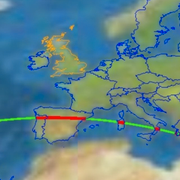
Första civila astronauten i Kina på väg ut i rymden
I morse lyfte en bemannad rymdfarkost från Kina med rymdstationen Tiangong som destination.
För första gången deltar en civil kinesisk besättningsman, professorn Gui Haichao, i en rymdresa. Hittills har alla kinesiska rymdfarare varit en del av den kinesiska militären. Gui ska leda vetenskapliga experiment som ska utföras under det fem månader långa uppdraget.
I går meddelade Kina att man planerar att sätta astronauter på månen innan 2030. USA har för avsikt att återvända till månen i slutet av 2025.
bakgrund
Kinas rymdprogram
Wikipedia (en)
The space program of the People's Republic of China is directed by the China National Space Administration (CNSA). China's space program has overseen the development and launch of ballistic missiles, thousands of artificial satellites, crewed spaceflight, an indigenous space station, and has stated plans to explore the Moon, Mars, and the broader Solar System.The technological roots of the Chinese space program trace back to the 1950s, when, with the help of the newly allied Soviet Union, China began development of its first ballistic missile and rocket programs in response to the perceived American (and, later, Soviet) threats. Driven by the successes of Soviet Sputnik 1 and American Explorer 1 satellite launches in 1957 and 1958 respectively, China would launch its first satellite, Dong Fang Hong 1 in April 1970 aboard a Long March 1 rocket making it the fifth nation to place a satellite in orbit. A year later, China began development on a crewed space mission but, under pressure from Mao's Cultural Revolution on academics, was shut down and resources put to China's first reconnaissance satellite program, Fanhui Shi Weixing, which had its maiden launch in November 1975. Chinese first crewed space program began in earnest several decades later, when an accelerated program of technological development culminated in Yang Liwei's successful 2003 flight aboard Shenzhou 5. This achievement made China the third country to independently send humans into space.Today, China has one of the most active space programs in the world. It conducts either the highest or the second highest number of orbital launches each year. It operates a satellite fleet consisting of a large number of communication, navigation, remote sensing and scientific research satellites. With spacecrafts reaching as far as the Moon and Mars, China has conducted multiple complex extraterrestrial exploration missions, including landing or even sample-return. In the near future, the Chinese space program is steadily pursuing a crewed mission to the Moon, space transportation, in-orbit maintenance of spacecraft, space telescope, counterspace capabilities, quantum communications, orbiter and sample-return missions to Mars, and exploration missions throughout the Solar System and deep space.
Omni är politiskt obundna och oberoende. Vi strävar efter att ge fler perspektiv på nyheterna. Har du frågor eller synpunkter kring vår rapportering? Kontakta redaktionen


